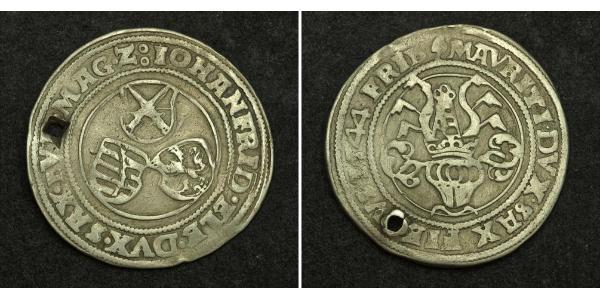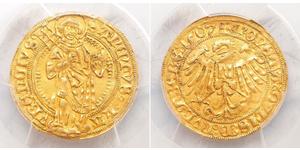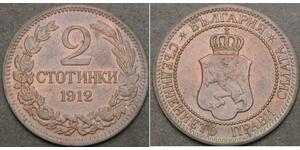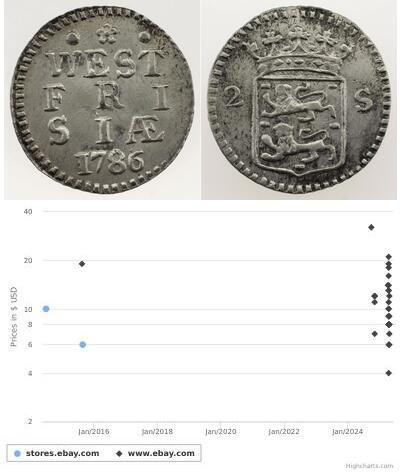(продана за $24.0)
1544, Saxony, John the Magnanimous & Maurice. Silver 1/4 Thaler Coin. R!
State: Saxony
Mint Year: 1544
References: Keilitz/kohl 135, MB#277. R!
Mint Place: Freiberg (privy mark: linden leaf)
Denomination: 1/4 Thaler (1/4 Guldengroschen)
Condition: Pierced and cleaned, otherwise VF+
Rulers: John Frederick I "the Magnanimous" & Maurice (1541-1547)
Diameter: 29mm
Material: Silver
Weight: 7.03gm
Obverse: Three shields with coat-of-arms within inner circle.
Legend: IOHEN FRID . ELE . DVX . SAX . BVR . BAG . Z :
Reverse: Ornate tournament helmet with family crest within inner circle.
Legend: (privy mark: linden leaf) MAVRITI . DVX . SAX . FIE . IVS . I544 . FRI
Johann Friedrich, the Protestant elector of Saxony, was an important figure in the religious wars of the 16th century. Not only was he a personal friend of Martin Luther, but the elector also made sweeping reforms in his lands in support of the Protestant cause. In 1546, Johann Friedrich became embroiled in the Schmalkaldic War against Catholic Holy Roman Emperor Karl V. For the elector, the outcome was not good: he was defeated by Karl V at the Battle of Mühlberg in 1547 and imprisoned. When his cousin Maurice attacked Karl V in 1552, he was released and restored to power as a duke of Saxony.
The siege was an event of the War of the League of Schmalkalden, in whose opening stages the ambitious Moritz strove to seize the Electoral dignity from his cousin Johann Friedrich of Saxony's Ernestine Line. Born in Freiburg in 1521, Moritz was educated as a Lutheran and married Agnes, daughter of the Protestant stalwart Philipp of Hessen. He followed a somewhat flexible policy during the wars of religion, guided by self-interest and striving always to enlarge his domains either in concert with Emperor Charles V or against him. After many successes, he was mortally wounded in the battle of Sievershausen in July 1553.
John Frederick I, Elector of Saxony (German: Johann Friedrich I; b. Torgau, 30 June 1503 - d. Weimar, 3 March 1554), called John the Magnanimous, was Elector of Saxony and Head of the Protestant Confederation of Germany (the Schmalkaldic League), "Champion of the Reformation".
John Frederick was the eldest son of John, Elector of Saxony by his first wife, Sofie of Mecklenburg-Schwerin. His mother died fourteen days after his birth, on 12 July 1503.
He received his education from George Spalatin, whom he highly esteemed during his whole life. Spalatin was Martin Luther's friend and advisor and thus, through Spalatin's schooling, John developed a devotion to the teachings of Martin Luther. His knowledge of history was comprehensive, and his library, which extended over all sciences, was one of the largest in Germany.
He cultivated a personal relationship with Martin Luther, beginning to correspond with him in the days when the bull of excommunication was hurled against the Reformer, and showing himself a convinced adherent of Luther. With vivid interest he observed the development of the reformatory movement. He eagerly read Luther's writings, urged the printing of the first complete (Wittenberg) edition of his works, and in the latter years of his life promoted the compilation of the Jena edition. At the Elector castle at Torgau, he constructed a chapel specifically designed to be a Lutheran place of worship and invited Martin Luther to deliver the inaugural sermon.
His father introduced him into the political and diplomatic affairs of the time, and he conducted the first negotiations of a treaty with Hesse in Kreuzburg and Friedewald. He took an active part in the disturbances caused by the Pack affair (see John the Steadfast), and Luther was grateful to him for his exertions, in spite of his youth, for the maintenance of peace.
During the second diet of Speyer (1529) he temporarily assumed the reins of government in place of his father. The intrigues of Archduke Ferdinand induced him after the diet to draw up a federal statute for the Evangelical estates, which shows that he was more decidedly convinced of the right and duty of defense than his father. He accompanied the latter to the Diet of Augsburg in 1530, signed with him the Augsburg Confession and was active in the proceedings. His attitude did not remain unnoticed, and won him the emperor's dislike.
In 1532, John Frederick succeeded his father as elector. In the beginning he reigned with his half-brother, John Ernest, but in 1542 became sole ruler.
Chancellor Brück, who for years had guided the foreign relations of the country with ability and prudence, remained also his councilor, but his open and impulsive nature often led him to disregard the propositions of his more experienced adviser, so that the country was in frequent danger, especially as John Frederick was not a far-sighted politician.
He consolidated the State Church by the institution of an electoral consistory (1542) and renewed the church visitation. He took a firmer and more decided stand than his father in favor of the Schmalkaldic League, but on account of his strictly Lutheran convictions was involved in difficulties with the Landgrave of Hesse, who favored a union with the Swiss and Strasburg Evangelicals. He was averse to all propositions of Popes Clement VII and Paul III to support calling a General Council, because he was convinced that it would only serve "for the preservation of the papal and anti-Christian rule"; but to be prepared for any event, he requested Luther to summarize all articles to which he would adhere before a council, and Luther wrote the Schmalkald Articles. At the Diet of Schmalkald in 1537 the council was refused, and the elector treated the papal legate with open disregard and rejected the propositions of Dr. Held, the imperial legate.
He followed the efforts at agreement at the conference of Regensburg in 1541 with suspicion and refused to accept the article on justification which had been drawn up under the supervision of Gasparo Contarini to suit both parties, and Luther, his steady adviser, confirmed him in his aversion. The efforts at agreement failed, and the elector contributed not a little to broaden the gulf by his interference in the ecclesiastical affairs of Halle and by aiding the Reformation which had been introduced there by Justus Jonas. His attitude became more and more stubborn and regardless of consequences, not to the advantage of the Protestant cause.
In spite of the warnings of the emperor, of Brück, and of Luther, he arbitrarily set aside in 1541 the election of Julius von Pflug to the see of Naumburg, instituted Nicolaus von Amsdorf as bishop, and introduced the Reformation. In 1542 he expelled Duke Henry of Brunswick-Wolfenbüttel from his country to protect the Evangelical cities Goslar and Brunswick and introduced the Reformation there. New war-like entanglements hindered Charles V from interfering and by apparently yielding he succeeded in concealing his true intentions. The elector appeared personally at the diet of Speyer in 1544. The harmony of the emperor with the Evangelicals appeared never greater than at that time. He permitted the Regensburg declaration of 1541 to be embodied in the new recess and acknowledged all innovations which the Evangelicals had made between 1532 and 1541 because he needed the aid of the Protestants against France. John Frederick actually thought that peace had come and continued the ecclesiastical reforms in his country. Even the growing discord among the allies did not disturb him.
When the Schmalkald War broke out in 1546, he marched to the south at the head of his troops, but the unexpected invasion of his country by his cousin Duke Maurice compelled him to return. He succeeded in reconquering the larger part of his possessions and repelling Maurice, but suddenly the emperor hastened north and surprised the elector. The Battle of Mühlberg, 24 April 1547, went against him and dispersed his army. He received a slashing wound to the left side of his face, leaving him with a disfiguring scar from his lower eye socket down his cheek. He was taken prisoner by Charles V and sent into exile in Worms.
Emperor Charles V condemned him to death as a convicted rebel; but, not to lose time in the siege of Wittenberg, which was defended by Sybille, the wife of the elector, he did not execute the sentence and entered into negotiations. To protect and save his wife and sons, and to prevent Wittenberg from being destroyed, John Frederick conceded the Capitulation of Wittenberg, and, after having been compelled to resign the government of his country in favor of Maurice of Saxony, his condemnation was changed into imprisonment for life.
He was never greater and more magnanimous than in the days of his captivity, as is evident from the correspondence with his children, his wife, and his councilors. Friends and foes were compelled to acknowledge his calm behavior, his unwavering faith, and his greatness under misfortune. He steadfastly refused to renounce the Protestant faith or to acknowledge the Augsburg Interim, declaring that by its acceptance he would commit "a sin against the Holy Ghost, because in many articles it was against the Word of God". Though offered several opportunities to be set free, if he would but compromise his faith and convictions, he steadfastly refused, and urged his sons to remain strong and faithful.
The sudden attack upon the emperor by Elector Maurice made an end of John Frederick's imprisonment, and he was released on 1 September 1552. He firmly refused to bind himself to comply in matters of religion with the decisions of a future council or diet, declaring that he was resolved to adhere until his grave to the doctrine contained in the Augsburg Confession. His homeward journey was a triumphal march. He removed the seat of government to Weimar and reformed the conditions of his country, but died within two years. A special object of his care was the University of Jena, which he planned in place of Wittenberg, which he had lost (1547). He died in Weimar, Germany.
Maurice (21 March 1521 - 9 July 1553) was Duke (1541-47) and later Elector (1547-53) of Saxony. His clever manipulation of alliances and disputes gained the Albertine branch of the Wettin dynasty extensive lands and the electoral dignity.
Maurice was the fourth child but first son of the still-Catholic Duke Henry IV and the Protestant Catherine of Mecklenburg-Schwerin.
In December 1532, Maurice, aged 11, came to live at the castle of his godfather Albert of Brandenburg, cardinal, archbishop of Magdeburg and archbishop of Mainz. During two years, he lived the reflective life of the cardinal until his uncle, the Duke George, demanded his return to his homeland and began the training of the later Saxonian Duke and educate him as a catholic. After 1536 Maurice's father was converted to the Protestant faith and the entire Duchy follow him; Heinrich and Katharina took the education of their son again into their hands and, when Maurice had 18 years, left his parents and moved with his older cousin John Frederick I, which resided in Torgau and was despised by Maurice; this originated a strong hate between both. With a further cousin, the Landgrave Philip I of Hesse, whom he met in Dresden, connected, however, in a lifetime friendship.
On 18 August 1541 the Duke Henry died, and Maurice, as the eldest son, succeeded him as the Duke of Saxony and Head of the Albertine Line. He replaced most of his advisors, because they had been against his marriage with Agnes since the beginning. George von Carlowitz, one of the new confidants of the Duke, advised Moritz (in order to prevent a war with the Emperor Charles V and his brother Ferdinand, at the same time King of the Romans and his neighbour -as a King of Bohemia-) not to endanger the continuation of the Protestant Movement.
Thus, he participated on the Emperor's Army in the war against the forces of Sultan Suleiman the Magnificent of the Ottoman Empire (1542), Duke William of Jülich-Cleves-Berg (1543), and King Francis I of France (1544). However, on the other hand, the Duke confiscated the properties of the Catholic Church in his lands, and was suitable so enormous possession on. From the fortune of dissolved monasteries Maurice in his country donated the Prince Schools (Fürstenschulen) in Schulpforta (100 places), Meissen (60 places) and Grimma (70 places). Legal basis for this was the "New National Order" (Neue Landesordnung) from 1543.
Later, Maurice, refused to join in the Protestant Schmalkaldic League, although the Landgrave Philip of Hesse, his friend and father-in-law, was the Leader of the League. As principal reason for this refusal the membership is generally regarded on his hate to his Ernestine cousin John Frederick I and the Imperial promise of the Saxon electorship, then held by John Frederick. Into the Holy Week of 1542, came between them in the process of the Wurzener Feud (Wurzener Fehde) nearly to a brother war, because John Frederick occupied the together administered "Wurzener Country". A controversy between Maurice and John Frederick had preceded over the use of the tax funds from this area. The intervention of the Landgrave Philip of Hesse and Martin Luther prevented the war.
Due to the energetic persistence of Elector John Frederick in establishing the Evangelical Faith, the Emperor Charles V, on 20 July 1546, imposed the Imperial Ban (Reichsacht) over him, with agreement of the Catholic Imperial Estates, enforcement of which was laid on Maurice after the Wurzener Feud. The emperor tried in this way to drive a wedge still more deeply into the Protestant camp in order to prevent a further propagation of the Protestant Faith. In case of successful enforcement, Maurice hoped to be invested by the emperor with the Electorship. Maurice hesitated for a long time, since by this punitive actions his father-in-law Philip of Hesse would have been affected also. But when the brother of the emperor, Ferdinand I, himself wanted to begin a campaign against Electoral Saxony, he had to forestall that, in order not to lose to the Habsburgs the initiative in his own countries.
Maurice returned to Charles's camp. After initial successes - he occupied Electoral Saxony nearly without a fight - Maurice with his army was pressed by the Schmalkaldic League and retreated toward Bohemia. In the crucial Battle of Mühlberg at the Elbe, the Emperor and his brother Ferdinand, as well as Maurice could defeat the Schmalkaldic League with the capture of Landgrave Philip and John Frederick. According to contemporary chronicles, all of this happened on one day, 24 April 1547. In order to escape being beheaded, John Frederick ceded the Electorate and sizable lands to Maurice in the Surrender of Wittemberg. Duke Maurice of Saxony was raised to the Electoral Dignity already briefly after the battle on 4 June 1547 in the field camp to the Elector of Saxony. The official appointment took place later, but at a high price: He had betrayed the Evangelical Faith and had brought his father-in-law, Philip of Hesse, into a hopeless situation. Maurice assured him that he would not be imprisoned, if he would surrender to the emperor. However, Philip was taken prisoner and exiled, after he had fallen on his knees before Charles V.
Maurice, insulted after these incidents by his compatriots as "Judas", was also disappointed for the emperor's attitude (because now Charles V tried to reintroduce Catholicism in the Empire's Protestant territories and the continued imprisonment of his father-in-law, Landgrave Philip of Hesse, whose freedom Charles V had guaranteed), he hid, however, his feelings from him up to the Diet of Augsburg on 25 February 1548, where the ceremony of the formal possession of Maurice as Elector of Saxony took place. Charles V, hoped, with his appointment as the Elector of Saxony the agreement as the Augsburg Interim too gotten, with whose assistance of the Emperor the faith splitting in the Empire wanted to terminate.
Commissioned to capture the rebellious Lutheran city of Magdeburg (1550), Maurice seized the occasion to raise an Army and signed anti-Habsburg compacts with France and Germany's Protestant princes.
In the Treaty of Chambord signed with the French King Henry II in January 1552 Maurice promised to the King money and weapon assistance for a campaign against Charles V. As return, Henry was able to take four Imperial cities (Metz, Toul, Verdun and Cambrai) should as well as their dioceses gotten, although Maurice was no right to have it.
In March 1552 the rebels overran southern German states, including parts of Austria, forcing the Emperor to flee and release Philip of Hesse. While Henry up to the Rhine advanced and occupied the promised Imperial lands, the emperor surprised by the attack fled over the Alps in the Carinthia Villach. In view of this success, Maurice quit his alliance with Henry II and negotiated with Charles's brother King Ferdinand I a treaty, which Charles agreed against-willingly. With the Peace of Passau, signed in August 1552, the Lutheran position was provisionally guaranteed. As part of the Peace, his former opponents from the Schmalkaldic War, John Frederick I of Saxony and the Landgrave Philipp of Hesse were released. The war was terminated in 1556 by Ferdinand I; the Imperial cities remained in French possession.
When Maurice returned to Saxony after the Peace of Passau, it was no longer the "Judas"; both Protestants and Catholics rendered it equally respect. Also the emperor admonished it in letters to provide at his place in the Empire for peace; shortly after, he campaigned against the Ottomans in Hungary. The Margrave Albert Alcibiades of Brandenburg-Kulmbach (who had rejected the Passau armistice) conquered soon thereafter the dioceses of Würzburg and Bamberg - under his control since eleven years before, after his former owner, John Frederick ceded them to him - as well as the Imperial city of Nuremberg. This was the beginning of the Second Margrave War, which ended only with the Peace of Augsburg of 1555.
In 1552 Maurice with the army of the Holy Roman Empire (11,000 men) march in Hungary. The Ottomans besieged Eger, but the Black Death broke out in Hungary, and Maurice daren't move along.
Albert Alcibiades was a former ally of Maurice, which fought in the Schmalkaldic War on his side. But now Maurice, accomplished at a prince alliance, among others, with Ferdinand I, was compelled to fight against Albert Alicibiades. On 9 July 1553 the Battle of Sievershausen taken place in Lehrte. Maurice won the battle; however, was hurt by a shot into the abdomen from the rear heavily and succumbed two days later in the field camp at the age of 32 years. He was buried in the Freiberg Cathedral. In 1853, 300 years after the Battle, the place of his death was commemorated with a monument established to it. The 7.5 tons heavy granite originates from his homeland in Saxony.
Because Maurice died without surviving male issue, his brother Augustus succeeded him as Elector. He established in Dresden, shortly after the death of Maurice, the Maurice Monument (Moritzmonument), the first historical monument in Saxony.

|
Добавив:
anonymous 2015-05-19 |
9 описів монет було покращено з 2025-05-28 по 2025-06-04
Одна з них:
1 Гульден Королівство Нідерланди (1815 - ...
в групі 5 монет / 5 цін
















-300-150-nRgsHgTyozIAAAGW7ltyjN9I.jpg)






